University Telehealth Project: System Analysis and Stakeholder Mapping
VerifiedAdded on 2020/05/11
|12
|1549
|55
Report
AI Summary
This report provides a system analysis of a telehealth project, specifically focusing on the After-hours Urgent Care Telehealth initiative in Australia. It begins with an introduction to the project and its purpose, which is to support healthcare in rural areas through videoconferencing. The report then delves into a detailed stakeholder map, categorizing stakeholders into internal and external, as well as executive and operational roles, and describing their interests in the project. A questionnaire designed to gather information from each stakeholder group is presented, followed by use case diagrams that illustrate the system's functionalities, including patient registration, login, data management, and prescription processes. The report concludes by emphasizing the importance of stakeholder involvement and the usefulness of the information system in improving healthcare access and emergency services in rural regions, supported by a comprehensive bibliography.
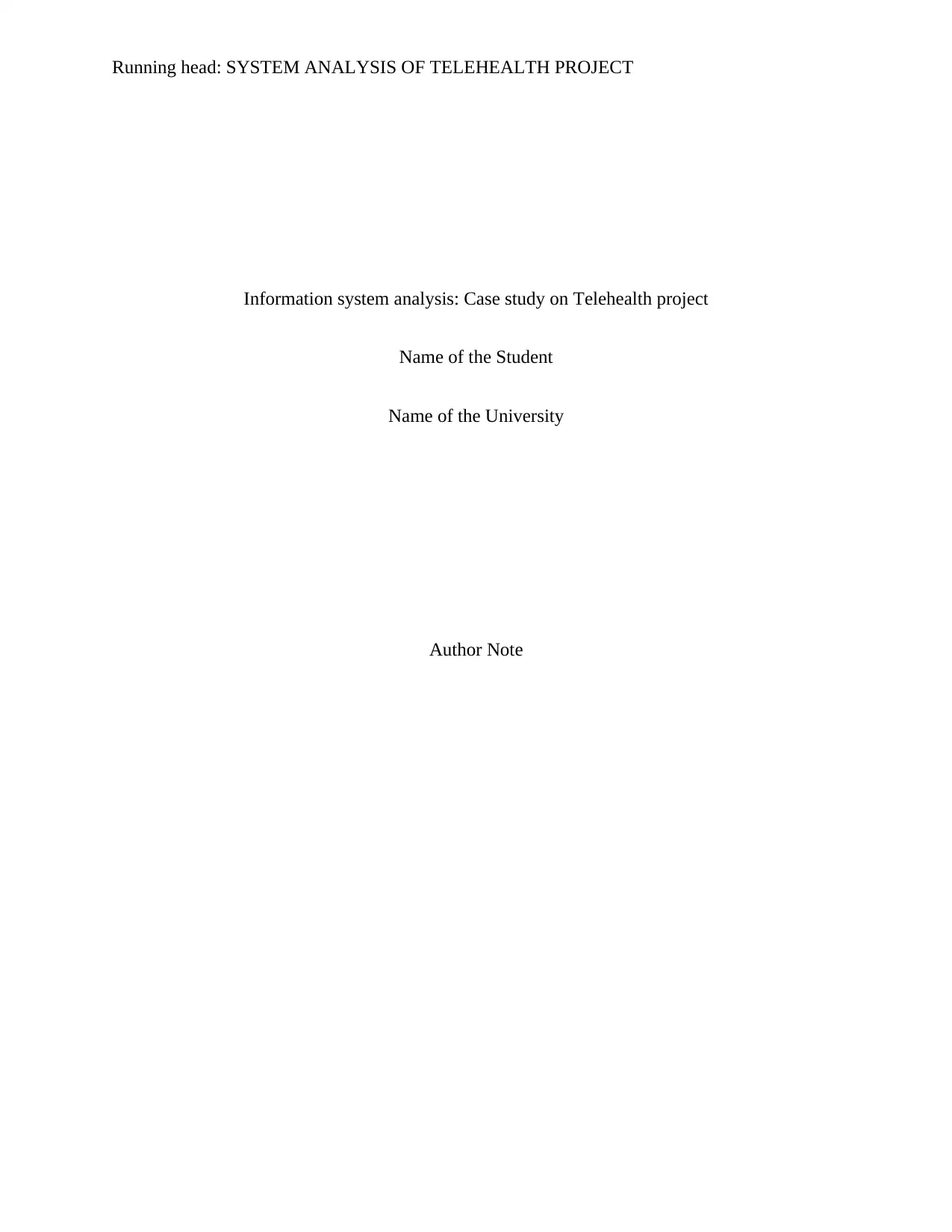
Running head: SYSTEM ANALYSIS OF TELEHEALTH PROJECT
Information system analysis: Case study on Telehealth project
Name of the Student
Name of the University
Author Note
Information system analysis: Case study on Telehealth project
Name of the Student
Name of the University
Author Note
Paraphrase This Document
Need a fresh take? Get an instant paraphrase of this document with our AI Paraphraser
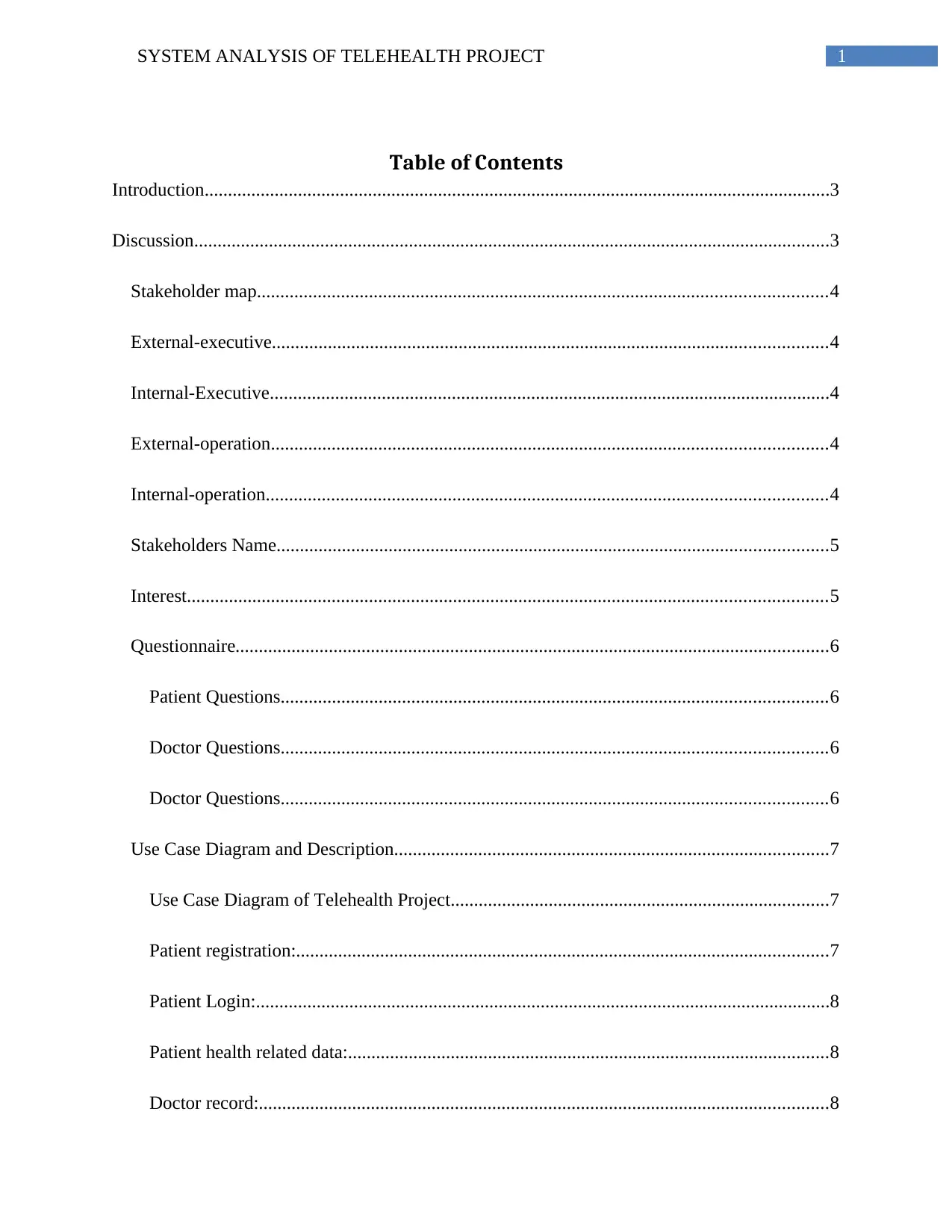
1SYSTEM ANALYSIS OF TELEHEALTH PROJECT
Table of Contents
Introduction......................................................................................................................................3
Discussion........................................................................................................................................3
Stakeholder map..........................................................................................................................4
External-executive.......................................................................................................................4
Internal-Executive........................................................................................................................4
External-operation.......................................................................................................................4
Internal-operation........................................................................................................................4
Stakeholders Name......................................................................................................................5
Interest.........................................................................................................................................5
Questionnaire...............................................................................................................................6
Patient Questions.....................................................................................................................6
Doctor Questions.....................................................................................................................6
Doctor Questions.....................................................................................................................6
Use Case Diagram and Description.............................................................................................7
Use Case Diagram of Telehealth Project.................................................................................7
Patient registration:..................................................................................................................7
Patient Login:...........................................................................................................................8
Patient health related data:.......................................................................................................8
Doctor record:..........................................................................................................................8
Table of Contents
Introduction......................................................................................................................................3
Discussion........................................................................................................................................3
Stakeholder map..........................................................................................................................4
External-executive.......................................................................................................................4
Internal-Executive........................................................................................................................4
External-operation.......................................................................................................................4
Internal-operation........................................................................................................................4
Stakeholders Name......................................................................................................................5
Interest.........................................................................................................................................5
Questionnaire...............................................................................................................................6
Patient Questions.....................................................................................................................6
Doctor Questions.....................................................................................................................6
Doctor Questions.....................................................................................................................6
Use Case Diagram and Description.............................................................................................7
Use Case Diagram of Telehealth Project.................................................................................7
Patient registration:..................................................................................................................7
Patient Login:...........................................................................................................................8
Patient health related data:.......................................................................................................8
Doctor record:..........................................................................................................................8
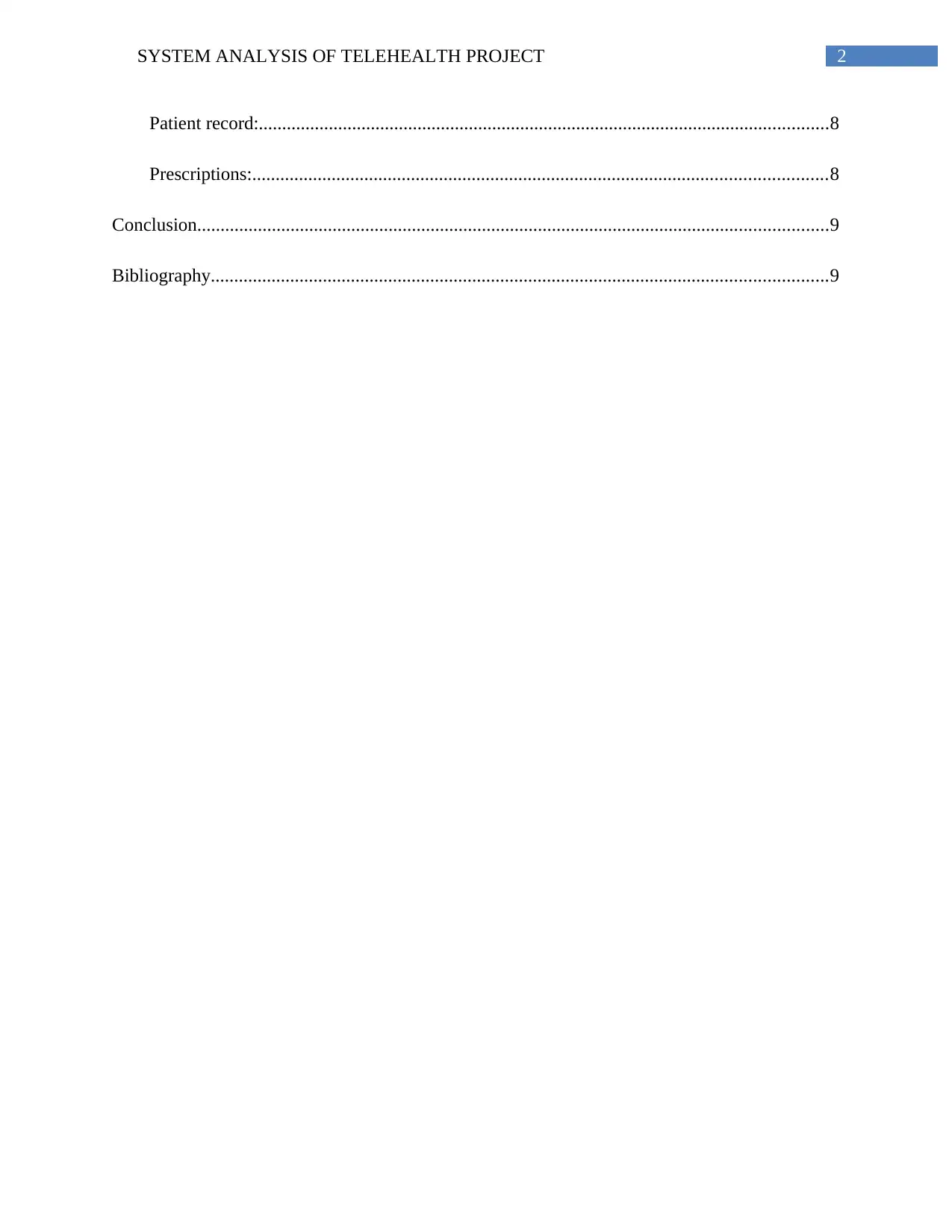
2SYSTEM ANALYSIS OF TELEHEALTH PROJECT
Patient record:..........................................................................................................................8
Prescriptions:...........................................................................................................................8
Conclusion.......................................................................................................................................9
Bibliography....................................................................................................................................9
Patient record:..........................................................................................................................8
Prescriptions:...........................................................................................................................8
Conclusion.......................................................................................................................................9
Bibliography....................................................................................................................................9
⊘ This is a preview!⊘
Do you want full access?
Subscribe today to unlock all pages.

Trusted by 1+ million students worldwide
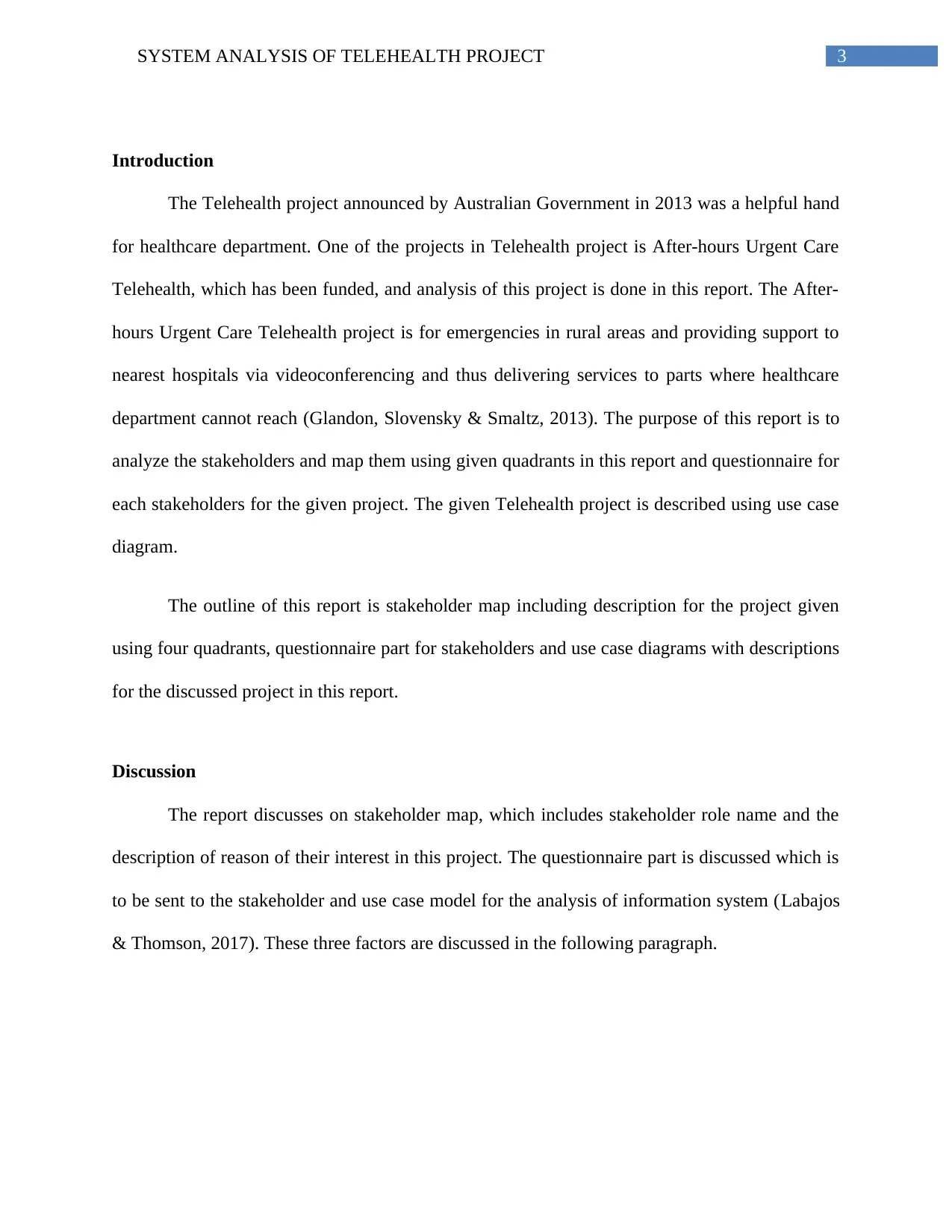
3SYSTEM ANALYSIS OF TELEHEALTH PROJECT
Introduction
The Telehealth project announced by Australian Government in 2013 was a helpful hand
for healthcare department. One of the projects in Telehealth project is After-hours Urgent Care
Telehealth, which has been funded, and analysis of this project is done in this report. The After-
hours Urgent Care Telehealth project is for emergencies in rural areas and providing support to
nearest hospitals via videoconferencing and thus delivering services to parts where healthcare
department cannot reach (Glandon, Slovensky & Smaltz, 2013). The purpose of this report is to
analyze the stakeholders and map them using given quadrants in this report and questionnaire for
each stakeholders for the given project. The given Telehealth project is described using use case
diagram.
The outline of this report is stakeholder map including description for the project given
using four quadrants, questionnaire part for stakeholders and use case diagrams with descriptions
for the discussed project in this report.
Discussion
The report discusses on stakeholder map, which includes stakeholder role name and the
description of reason of their interest in this project. The questionnaire part is discussed which is
to be sent to the stakeholder and use case model for the analysis of information system (Labajos
& Thomson, 2017). These three factors are discussed in the following paragraph.
Introduction
The Telehealth project announced by Australian Government in 2013 was a helpful hand
for healthcare department. One of the projects in Telehealth project is After-hours Urgent Care
Telehealth, which has been funded, and analysis of this project is done in this report. The After-
hours Urgent Care Telehealth project is for emergencies in rural areas and providing support to
nearest hospitals via videoconferencing and thus delivering services to parts where healthcare
department cannot reach (Glandon, Slovensky & Smaltz, 2013). The purpose of this report is to
analyze the stakeholders and map them using given quadrants in this report and questionnaire for
each stakeholders for the given project. The given Telehealth project is described using use case
diagram.
The outline of this report is stakeholder map including description for the project given
using four quadrants, questionnaire part for stakeholders and use case diagrams with descriptions
for the discussed project in this report.
Discussion
The report discusses on stakeholder map, which includes stakeholder role name and the
description of reason of their interest in this project. The questionnaire part is discussed which is
to be sent to the stakeholder and use case model for the analysis of information system (Labajos
& Thomson, 2017). These three factors are discussed in the following paragraph.
Paraphrase This Document
Need a fresh take? Get an instant paraphrase of this document with our AI Paraphraser
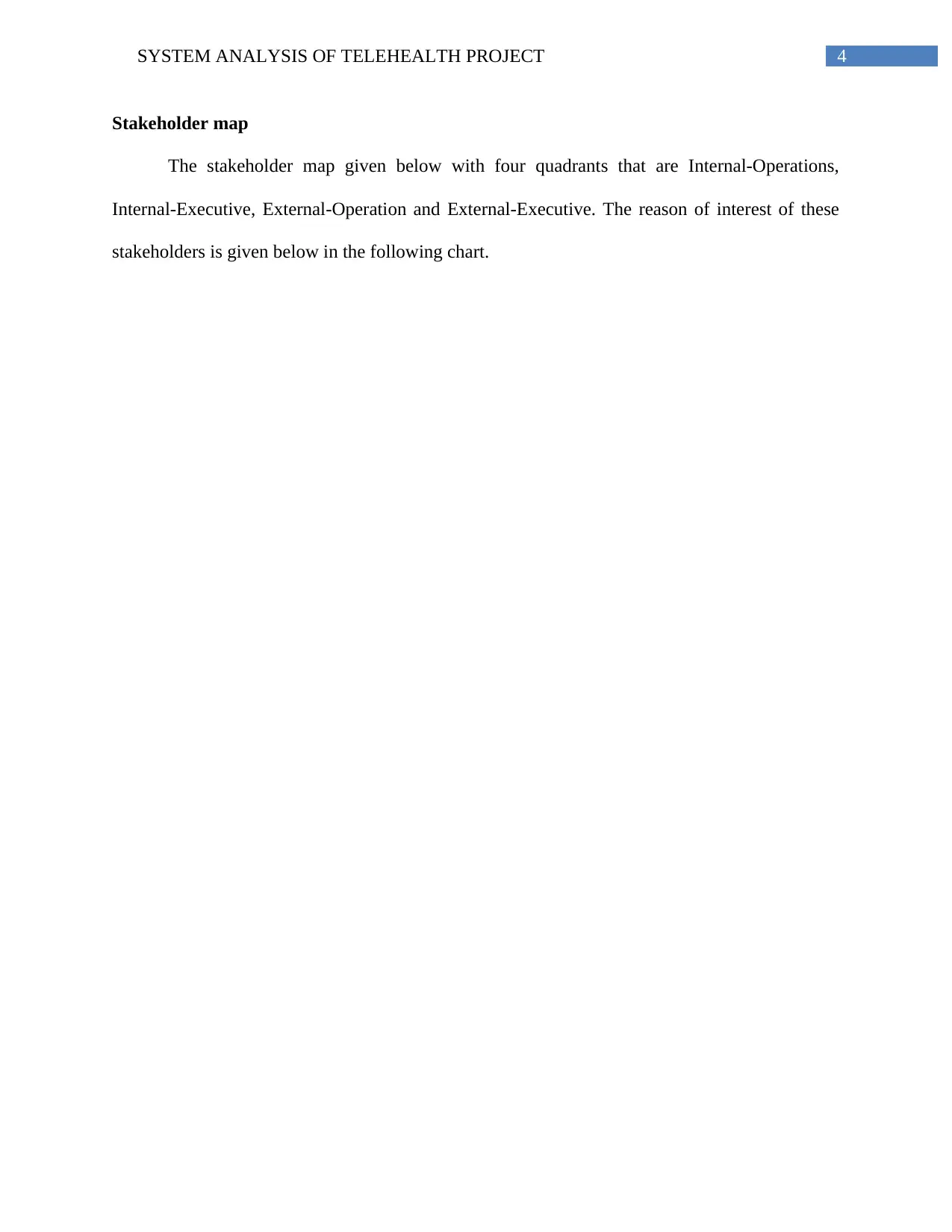
4SYSTEM ANALYSIS OF TELEHEALTH PROJECT
Stakeholder map
The stakeholder map given below with four quadrants that are Internal-Operations,
Internal-Executive, External-Operation and External-Executive. The reason of interest of these
stakeholders is given below in the following chart.
Stakeholder map
The stakeholder map given below with four quadrants that are Internal-Operations,
Internal-Executive, External-Operation and External-Executive. The reason of interest of these
stakeholders is given below in the following chart.
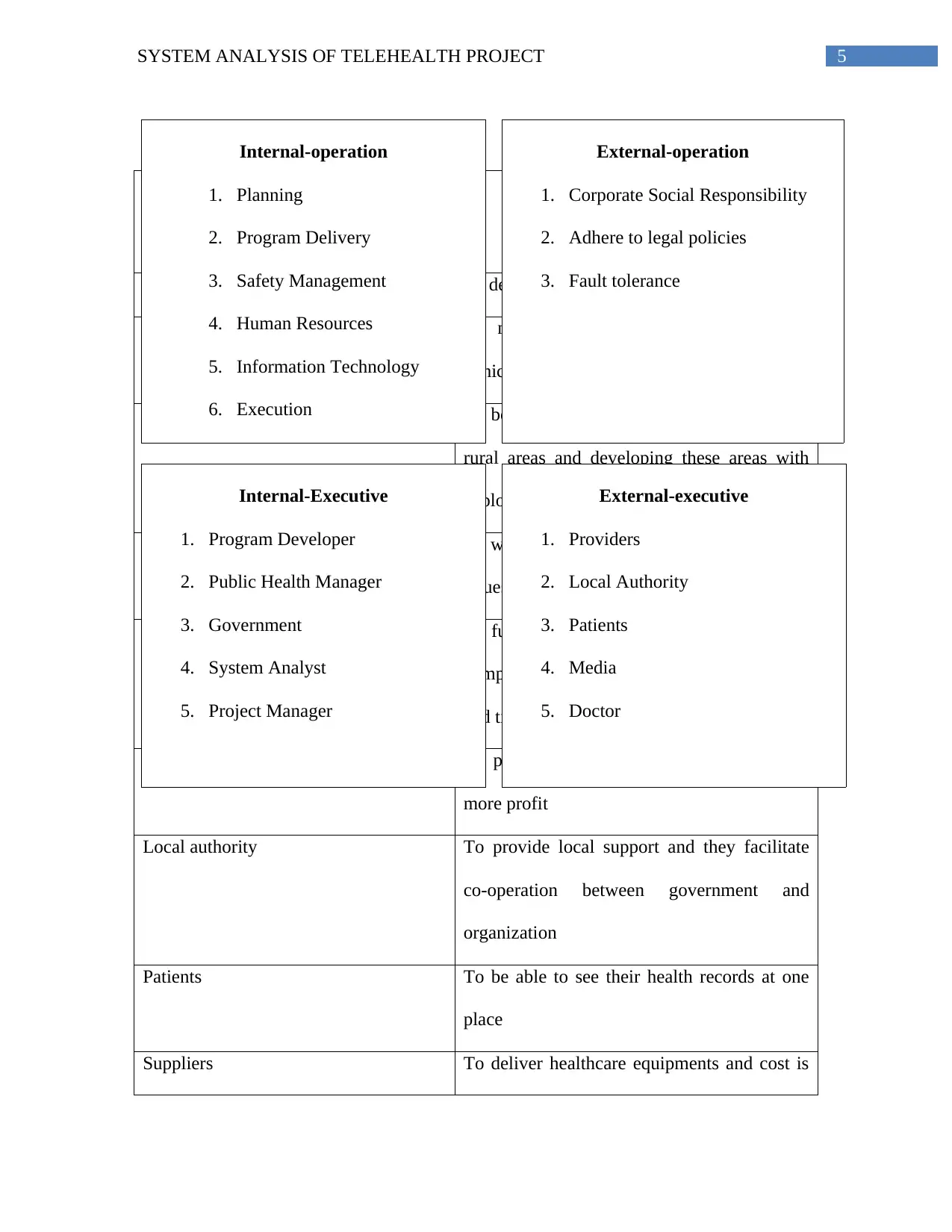
5SYSTEM ANALYSIS OF TELEHEALTH PROJECT
Stakeholders Name Interest
Program developer To develop the program properly
Public health manager To manage the overall project and non-
clinical operations of organization
Government To be able to provide better infrastructure to
rural areas and developing these areas with
deploying this type of project
System Analyst To work and analyze the system without any
issues arising
Project manager To fulfill all the requirements of project and
complete the project within agreed conditions
and timeline
Providers To provide system with better services and
more profit
Local authority To provide local support and they facilitate
co-operation between government and
organization
Patients To be able to see their health records at one
place
Suppliers To deliver healthcare equipments and cost is
Internal-operation
1. Planning
2. Program Delivery
3. Safety Management
4. Human Resources
5. Information Technology
6. Execution
Internal-Executive
1. Program Developer
2. Public Health Manager
3. Government
4. System Analyst
5. Project Manager
External-executive
1. Providers
2. Local Authority
3. Patients
4. Media
5. Doctor
External-operation
1. Corporate Social Responsibility
2. Adhere to legal policies
3. Fault tolerance
Stakeholders Name Interest
Program developer To develop the program properly
Public health manager To manage the overall project and non-
clinical operations of organization
Government To be able to provide better infrastructure to
rural areas and developing these areas with
deploying this type of project
System Analyst To work and analyze the system without any
issues arising
Project manager To fulfill all the requirements of project and
complete the project within agreed conditions
and timeline
Providers To provide system with better services and
more profit
Local authority To provide local support and they facilitate
co-operation between government and
organization
Patients To be able to see their health records at one
place
Suppliers To deliver healthcare equipments and cost is
Internal-operation
1. Planning
2. Program Delivery
3. Safety Management
4. Human Resources
5. Information Technology
6. Execution
Internal-Executive
1. Program Developer
2. Public Health Manager
3. Government
4. System Analyst
5. Project Manager
External-executive
1. Providers
2. Local Authority
3. Patients
4. Media
5. Doctor
External-operation
1. Corporate Social Responsibility
2. Adhere to legal policies
3. Fault tolerance
⊘ This is a preview!⊘
Do you want full access?
Subscribe today to unlock all pages.

Trusted by 1+ million students worldwide
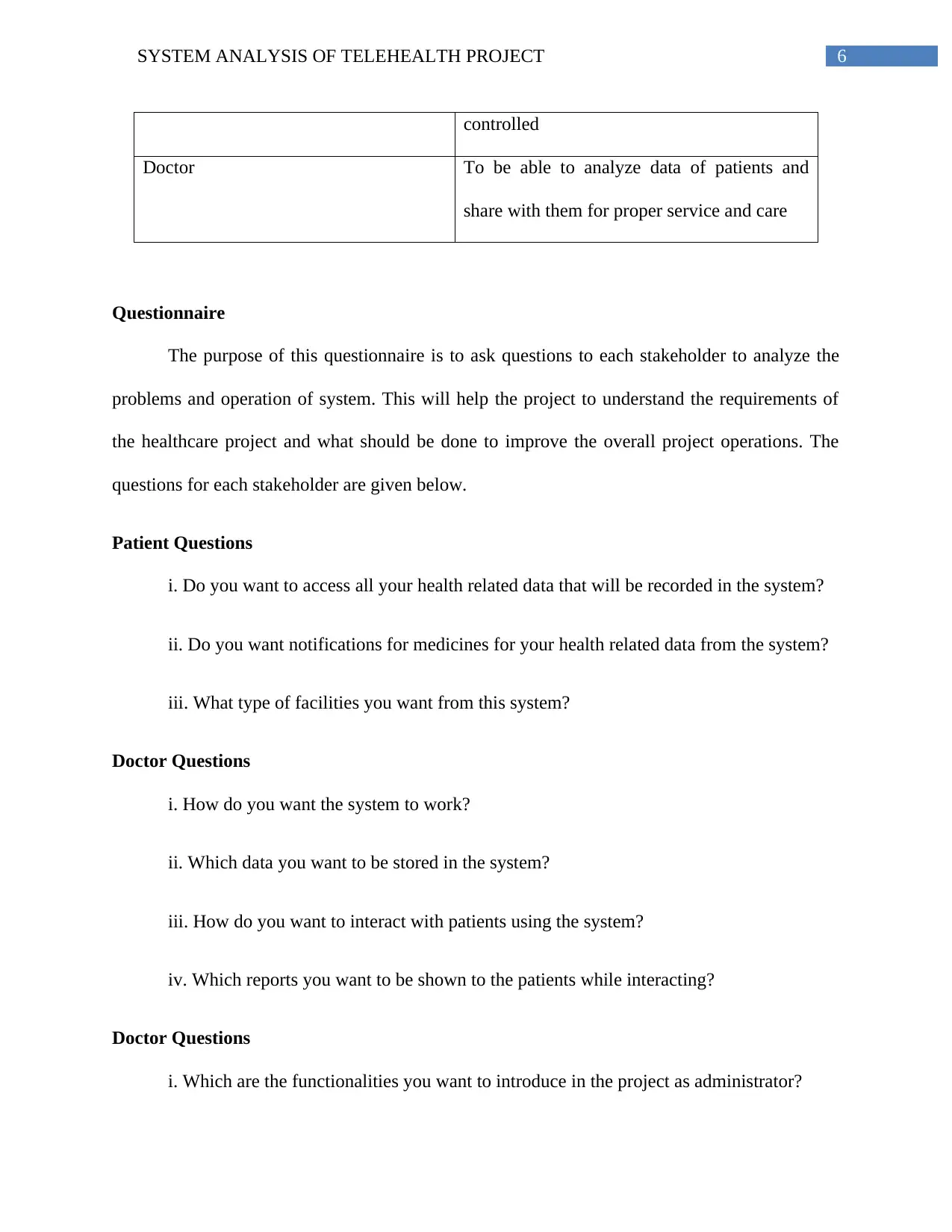
6SYSTEM ANALYSIS OF TELEHEALTH PROJECT
controlled
Doctor To be able to analyze data of patients and
share with them for proper service and care
Questionnaire
The purpose of this questionnaire is to ask questions to each stakeholder to analyze the
problems and operation of system. This will help the project to understand the requirements of
the healthcare project and what should be done to improve the overall project operations. The
questions for each stakeholder are given below.
Patient Questions
i. Do you want to access all your health related data that will be recorded in the system?
ii. Do you want notifications for medicines for your health related data from the system?
iii. What type of facilities you want from this system?
Doctor Questions
i. How do you want the system to work?
ii. Which data you want to be stored in the system?
iii. How do you want to interact with patients using the system?
iv. Which reports you want to be shown to the patients while interacting?
Doctor Questions
i. Which are the functionalities you want to introduce in the project as administrator?
controlled
Doctor To be able to analyze data of patients and
share with them for proper service and care
Questionnaire
The purpose of this questionnaire is to ask questions to each stakeholder to analyze the
problems and operation of system. This will help the project to understand the requirements of
the healthcare project and what should be done to improve the overall project operations. The
questions for each stakeholder are given below.
Patient Questions
i. Do you want to access all your health related data that will be recorded in the system?
ii. Do you want notifications for medicines for your health related data from the system?
iii. What type of facilities you want from this system?
Doctor Questions
i. How do you want the system to work?
ii. Which data you want to be stored in the system?
iii. How do you want to interact with patients using the system?
iv. Which reports you want to be shown to the patients while interacting?
Doctor Questions
i. Which are the functionalities you want to introduce in the project as administrator?
Paraphrase This Document
Need a fresh take? Get an instant paraphrase of this document with our AI Paraphraser
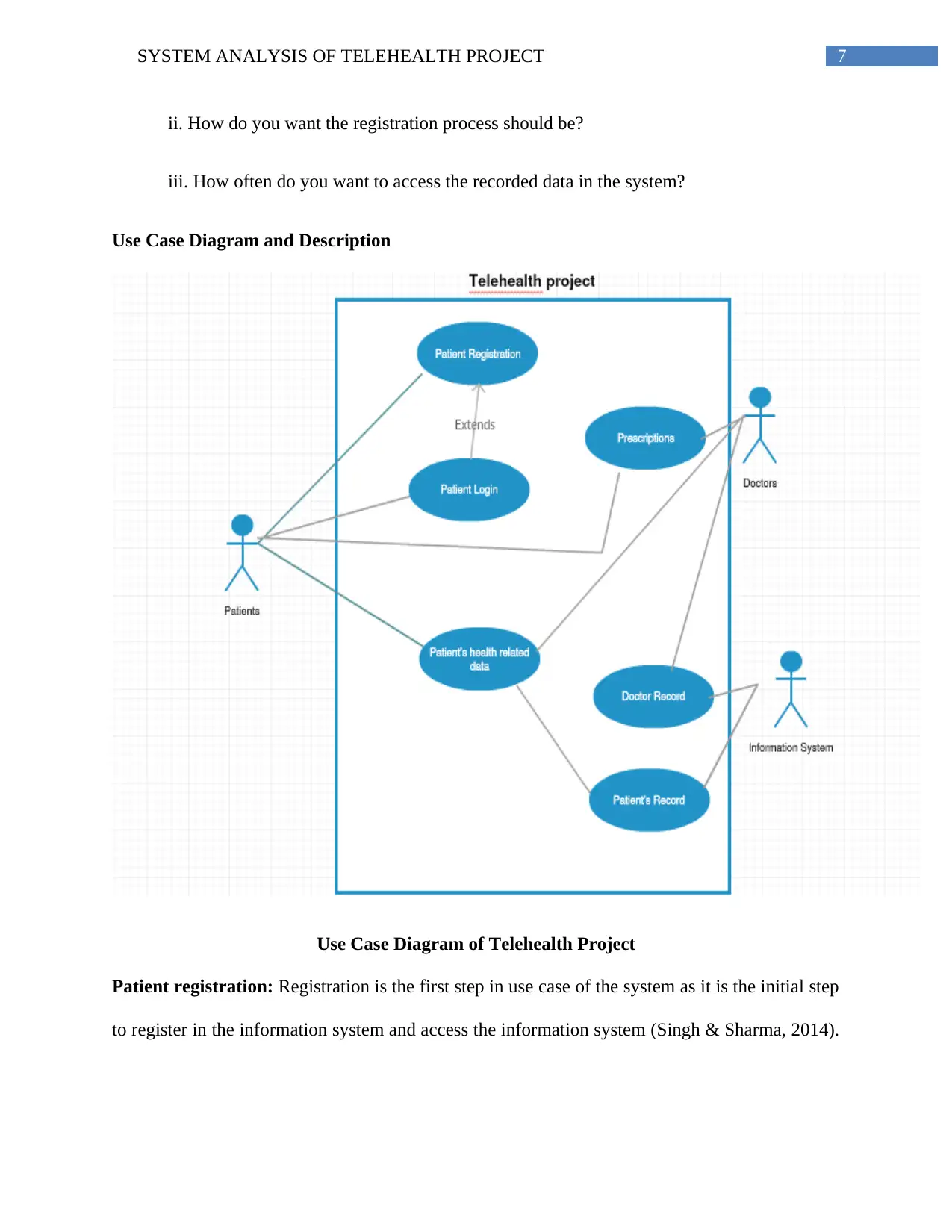
7SYSTEM ANALYSIS OF TELEHEALTH PROJECT
ii. How do you want the registration process should be?
iii. How often do you want to access the recorded data in the system?
Use Case Diagram and Description
Use Case Diagram of Telehealth Project
Patient registration: Registration is the first step in use case of the system as it is the initial step
to register in the information system and access the information system (Singh & Sharma, 2014).
ii. How do you want the registration process should be?
iii. How often do you want to access the recorded data in the system?
Use Case Diagram and Description
Use Case Diagram of Telehealth Project
Patient registration: Registration is the first step in use case of the system as it is the initial step
to register in the information system and access the information system (Singh & Sharma, 2014).
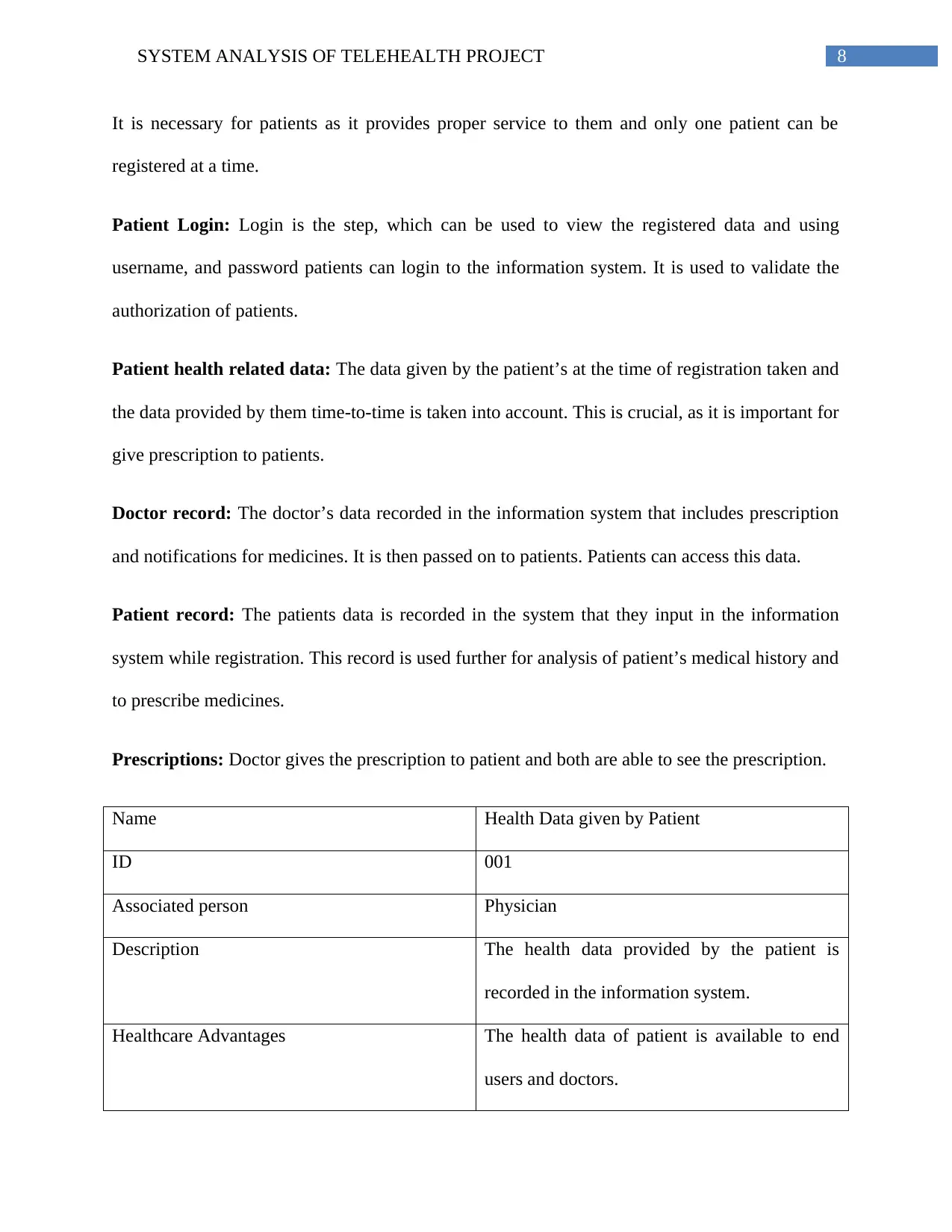
8SYSTEM ANALYSIS OF TELEHEALTH PROJECT
It is necessary for patients as it provides proper service to them and only one patient can be
registered at a time.
Patient Login: Login is the step, which can be used to view the registered data and using
username, and password patients can login to the information system. It is used to validate the
authorization of patients.
Patient health related data: The data given by the patient’s at the time of registration taken and
the data provided by them time-to-time is taken into account. This is crucial, as it is important for
give prescription to patients.
Doctor record: The doctor’s data recorded in the information system that includes prescription
and notifications for medicines. It is then passed on to patients. Patients can access this data.
Patient record: The patients data is recorded in the system that they input in the information
system while registration. This record is used further for analysis of patient’s medical history and
to prescribe medicines.
Prescriptions: Doctor gives the prescription to patient and both are able to see the prescription.
Name Health Data given by Patient
ID 001
Associated person Physician
Description The health data provided by the patient is
recorded in the information system.
Healthcare Advantages The health data of patient is available to end
users and doctors.
It is necessary for patients as it provides proper service to them and only one patient can be
registered at a time.
Patient Login: Login is the step, which can be used to view the registered data and using
username, and password patients can login to the information system. It is used to validate the
authorization of patients.
Patient health related data: The data given by the patient’s at the time of registration taken and
the data provided by them time-to-time is taken into account. This is crucial, as it is important for
give prescription to patients.
Doctor record: The doctor’s data recorded in the information system that includes prescription
and notifications for medicines. It is then passed on to patients. Patients can access this data.
Patient record: The patients data is recorded in the system that they input in the information
system while registration. This record is used further for analysis of patient’s medical history and
to prescribe medicines.
Prescriptions: Doctor gives the prescription to patient and both are able to see the prescription.
Name Health Data given by Patient
ID 001
Associated person Physician
Description The health data provided by the patient is
recorded in the information system.
Healthcare Advantages The health data of patient is available to end
users and doctors.
⊘ This is a preview!⊘
Do you want full access?
Subscribe today to unlock all pages.

Trusted by 1+ million students worldwide
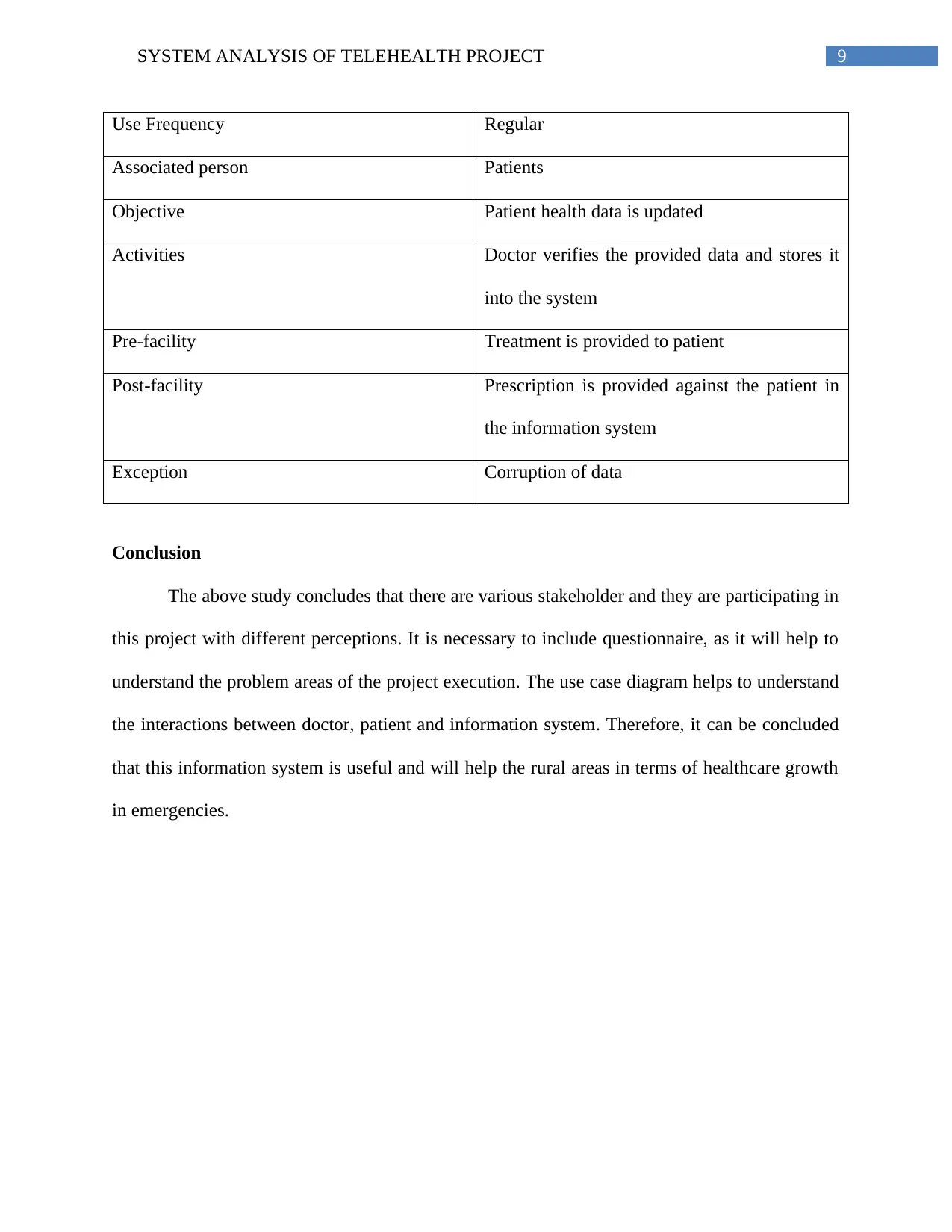
9SYSTEM ANALYSIS OF TELEHEALTH PROJECT
Use Frequency Regular
Associated person Patients
Objective Patient health data is updated
Activities Doctor verifies the provided data and stores it
into the system
Pre-facility Treatment is provided to patient
Post-facility Prescription is provided against the patient in
the information system
Exception Corruption of data
Conclusion
The above study concludes that there are various stakeholder and they are participating in
this project with different perceptions. It is necessary to include questionnaire, as it will help to
understand the problem areas of the project execution. The use case diagram helps to understand
the interactions between doctor, patient and information system. Therefore, it can be concluded
that this information system is useful and will help the rural areas in terms of healthcare growth
in emergencies.
Use Frequency Regular
Associated person Patients
Objective Patient health data is updated
Activities Doctor verifies the provided data and stores it
into the system
Pre-facility Treatment is provided to patient
Post-facility Prescription is provided against the patient in
the information system
Exception Corruption of data
Conclusion
The above study concludes that there are various stakeholder and they are participating in
this project with different perceptions. It is necessary to include questionnaire, as it will help to
understand the problem areas of the project execution. The use case diagram helps to understand
the interactions between doctor, patient and information system. Therefore, it can be concluded
that this information system is useful and will help the rural areas in terms of healthcare growth
in emergencies.
Paraphrase This Document
Need a fresh take? Get an instant paraphrase of this document with our AI Paraphraser
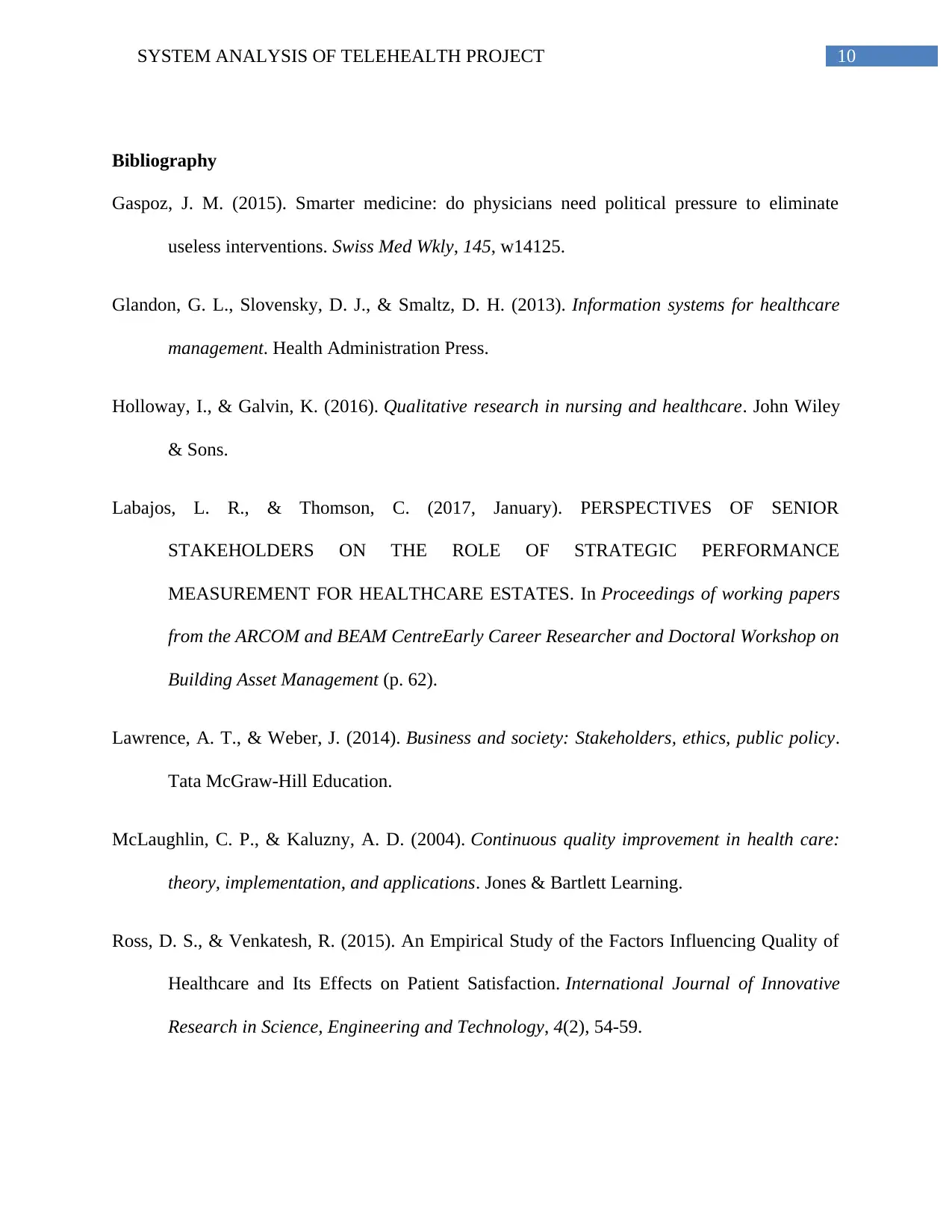
10SYSTEM ANALYSIS OF TELEHEALTH PROJECT
Bibliography
Gaspoz, J. M. (2015). Smarter medicine: do physicians need political pressure to eliminate
useless interventions. Swiss Med Wkly, 145, w14125.
Glandon, G. L., Slovensky, D. J., & Smaltz, D. H. (2013). Information systems for healthcare
management. Health Administration Press.
Holloway, I., & Galvin, K. (2016). Qualitative research in nursing and healthcare. John Wiley
& Sons.
Labajos, L. R., & Thomson, C. (2017, January). PERSPECTIVES OF SENIOR
STAKEHOLDERS ON THE ROLE OF STRATEGIC PERFORMANCE
MEASUREMENT FOR HEALTHCARE ESTATES. In Proceedings of working papers
from the ARCOM and BEAM CentreEarly Career Researcher and Doctoral Workshop on
Building Asset Management (p. 62).
Lawrence, A. T., & Weber, J. (2014). Business and society: Stakeholders, ethics, public policy.
Tata McGraw-Hill Education.
McLaughlin, C. P., & Kaluzny, A. D. (2004). Continuous quality improvement in health care:
theory, implementation, and applications. Jones & Bartlett Learning.
Ross, D. S., & Venkatesh, R. (2015). An Empirical Study of the Factors Influencing Quality of
Healthcare and Its Effects on Patient Satisfaction. International Journal of Innovative
Research in Science, Engineering and Technology, 4(2), 54-59.
Bibliography
Gaspoz, J. M. (2015). Smarter medicine: do physicians need political pressure to eliminate
useless interventions. Swiss Med Wkly, 145, w14125.
Glandon, G. L., Slovensky, D. J., & Smaltz, D. H. (2013). Information systems for healthcare
management. Health Administration Press.
Holloway, I., & Galvin, K. (2016). Qualitative research in nursing and healthcare. John Wiley
& Sons.
Labajos, L. R., & Thomson, C. (2017, January). PERSPECTIVES OF SENIOR
STAKEHOLDERS ON THE ROLE OF STRATEGIC PERFORMANCE
MEASUREMENT FOR HEALTHCARE ESTATES. In Proceedings of working papers
from the ARCOM and BEAM CentreEarly Career Researcher and Doctoral Workshop on
Building Asset Management (p. 62).
Lawrence, A. T., & Weber, J. (2014). Business and society: Stakeholders, ethics, public policy.
Tata McGraw-Hill Education.
McLaughlin, C. P., & Kaluzny, A. D. (2004). Continuous quality improvement in health care:
theory, implementation, and applications. Jones & Bartlett Learning.
Ross, D. S., & Venkatesh, R. (2015). An Empirical Study of the Factors Influencing Quality of
Healthcare and Its Effects on Patient Satisfaction. International Journal of Innovative
Research in Science, Engineering and Technology, 4(2), 54-59.
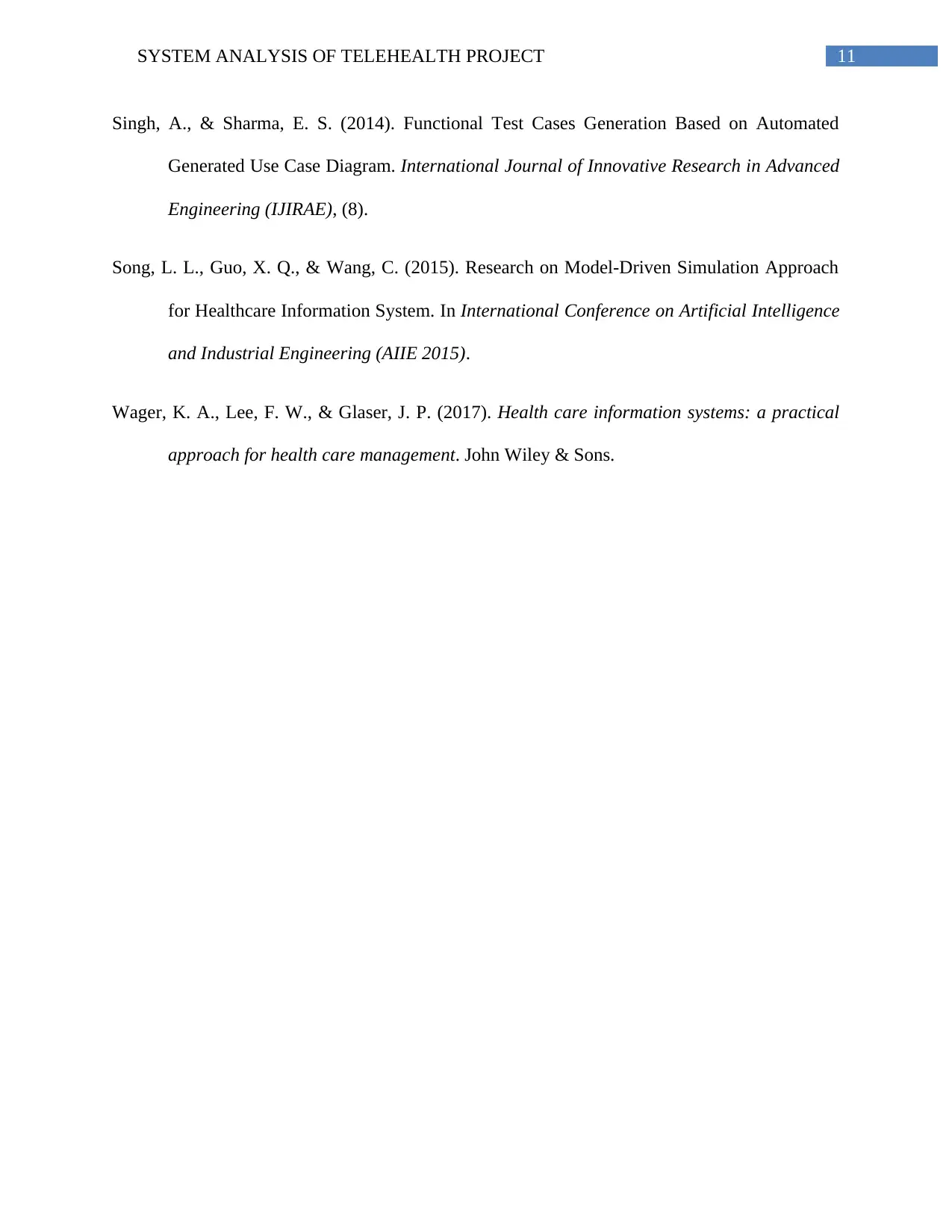
11SYSTEM ANALYSIS OF TELEHEALTH PROJECT
Singh, A., & Sharma, E. S. (2014). Functional Test Cases Generation Based on Automated
Generated Use Case Diagram. International Journal of Innovative Research in Advanced
Engineering (IJIRAE), (8).
Song, L. L., Guo, X. Q., & Wang, C. (2015). Research on Model-Driven Simulation Approach
for Healthcare Information System. In International Conference on Artificial Intelligence
and Industrial Engineering (AIIE 2015).
Wager, K. A., Lee, F. W., & Glaser, J. P. (2017). Health care information systems: a practical
approach for health care management. John Wiley & Sons.
Singh, A., & Sharma, E. S. (2014). Functional Test Cases Generation Based on Automated
Generated Use Case Diagram. International Journal of Innovative Research in Advanced
Engineering (IJIRAE), (8).
Song, L. L., Guo, X. Q., & Wang, C. (2015). Research on Model-Driven Simulation Approach
for Healthcare Information System. In International Conference on Artificial Intelligence
and Industrial Engineering (AIIE 2015).
Wager, K. A., Lee, F. W., & Glaser, J. P. (2017). Health care information systems: a practical
approach for health care management. John Wiley & Sons.
⊘ This is a preview!⊘
Do you want full access?
Subscribe today to unlock all pages.

Trusted by 1+ million students worldwide
1 out of 12
Related Documents
Your All-in-One AI-Powered Toolkit for Academic Success.
+13062052269
info@desklib.com
Available 24*7 on WhatsApp / Email
![[object Object]](/_next/static/media/star-bottom.7253800d.svg)
Unlock your academic potential
Copyright © 2020–2025 A2Z Services. All Rights Reserved. Developed and managed by ZUCOL.





